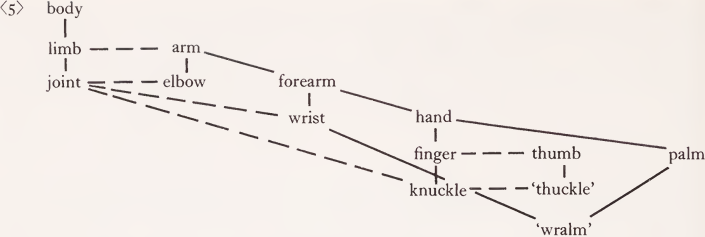
Hierarchies among lexical items
 المؤلف:
THOMAS G. BEVER and PETER S. ROSENBAUM
المؤلف:
THOMAS G. BEVER and PETER S. ROSENBAUM
 المصدر:
Semantics AN INTERDISCIPLINARY READER IN PHILOSOPHY, LINGUISTICS AND PSYCHOLOGY
المصدر:
Semantics AN INTERDISCIPLINARY READER IN PHILOSOPHY, LINGUISTICS AND PSYCHOLOGY
 الجزء والصفحة:
589-33
الجزء والصفحة:
589-33
 2024-08-27
2024-08-27
 1205
1205
Hierarchies among lexical items
Not all semantic phenomena can be handled by binary features, even if those features are related in a class-inclusion hierarchy. Consider the sentences in (4). Why is it that the sentences on the right are grammatically deviant? It is not simply the case that they are counterfactual, since (4 ei) is counterfactual, but does not involve the same kind of violation as (4 eii). The first doesn’t happen to be true; the second couldn’t possibly be true.

These facts justify the assumption that lexical entries are themselves arranged in two simultaneous hierarchies: one represents the inalienable inclusion of Have, and the other represents the class membership of Be. In (5) the solid vertical lines represent the Have hierarchy and the dotted horizontal lines represent the Be hierarchy. [We use the convention that the subject of an inalienable Have sentence must dominate the object in this tree, and that the subject of a generic Be must be dominated by the predicate object. Thus we can say, ‘the body has an arm’, ‘the arm is a limb ’, but not the reverse.]

Figure )5( demonstrates why it is the case that semantic features with a limited number of states cannot handle these relations and block the kinds of incorrect sentences on the right in (6) a body has an arm an arm has a forearm a forearm has a hand a hand has a finger a finger has a knuckle Figure )5( allows the sentences in )6):

Any reversal of the nouns in these sentences would produce a deviant sentence, so that just to handle these cases a binary feature analysis would require six states.
It is clear that we must distinguish between lexically permanent hierarchies as in (5) and the productive use of ‘have’ and ‘be’ in actual sentences. Thus the fact that we can say ‘ the tree is nice ’ and ‘ a tree has importance ’ does not necessarily require a corresponding lexical hierarchy. Such sentences with ‘ Be ’ and ‘ Have ’ are ‘ productive ’ (or alienable) uses of Have and Be rather than the ‘ lexical ’ (inalienable) use exemplified in (4) and (6).
 الاكثر قراءة في Semantics
الاكثر قراءة في Semantics
 اخر الاخبار
اخر الاخبار
اخبار العتبة العباسية المقدسة


